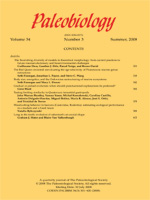Teleost otoliths are located in the membranous labyrinth and are mainly composed of aragonite and a small amount of organic matrix. Their rhythmic growth may provide important data about age, growth, maturity, and life-history events.
This article presents insights into paleoecological and evolutionary details from a study of the otolith microstructure of Trisopterus kasselensis, Trisopterus sculptus, and Pterothrissus umbonatus (Oligo-Miocene, North Sea Basin). Otoliths of Recent Trisopterus minutus were analyzed using the same methods (light and electron microscopy, thin slides) as a basis for comparison with the fossil sample.
Growth structures similar in size and aspect to the seasonal and daily growth increments in living fish indicate both individual age and early life transitions in habitat and life strategy suggesting planktonic larvae and benthic juveniles. The aspect of rhythmic growth patterns is due to lunar periodicity, a common feature in fish otoliths. Moreover, fossil Trisopterus show an phylogenetic increase in otolith—and consequently—somatic growth, indicating a change of life strategy during evolution (Oligocene to Recent).
Thus the internal structure of fossil otoliths allows the determination of growth, age composition, and early life history of fossil fish, as well as their direct comparison with living relatives.





